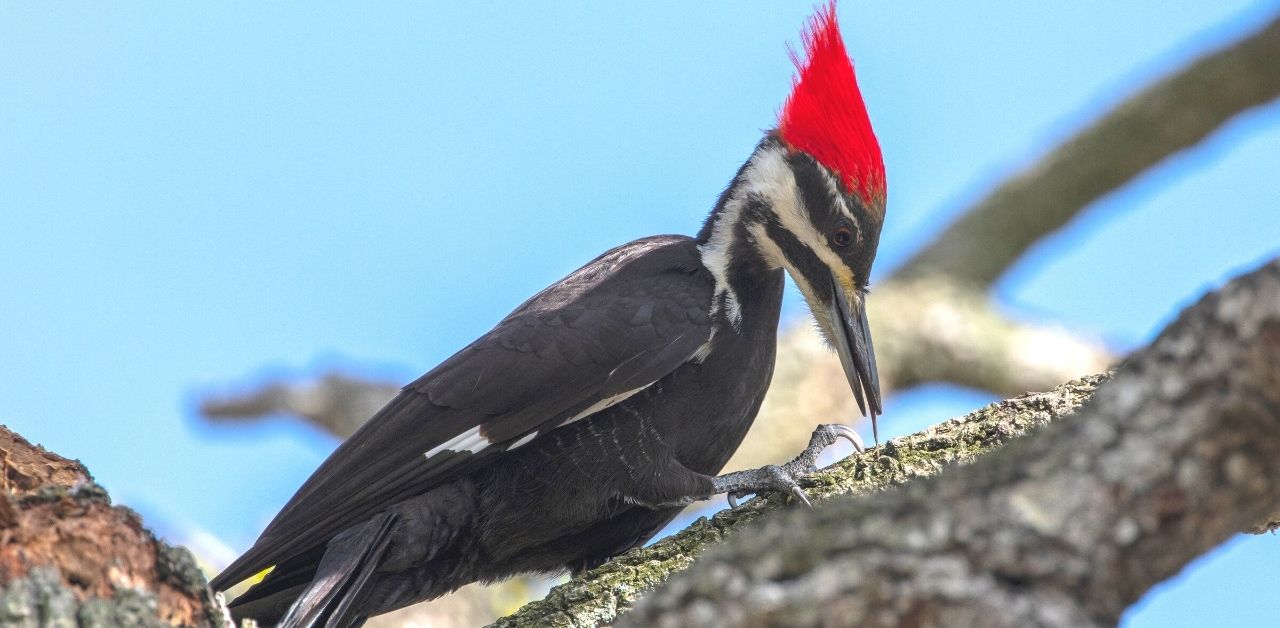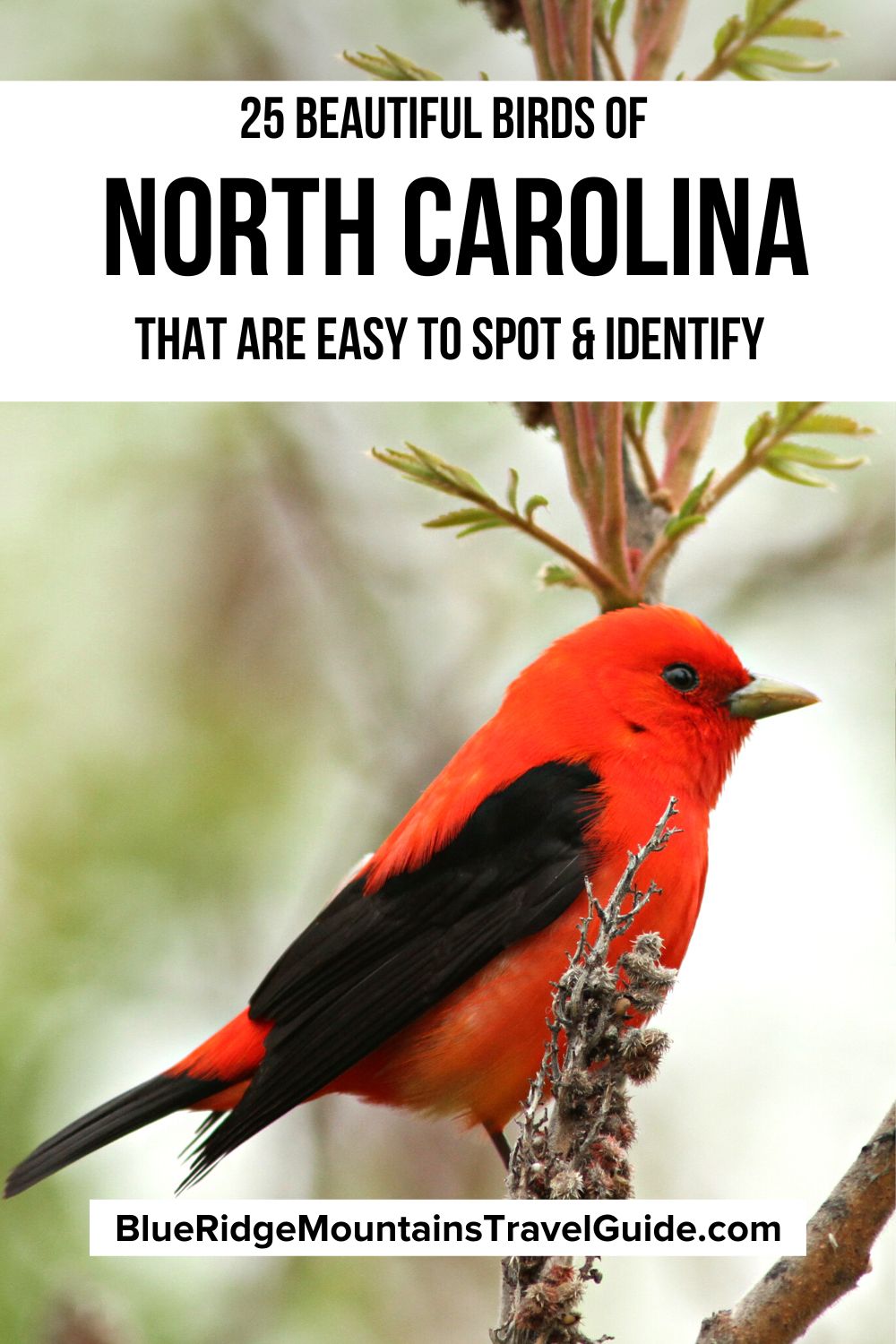[Updated March 9, 2023] There are over 400 species of birds in North Carolina, including native and migratory species. This makes the state a great place for enthusiastic birders as well as less knowledgeable novices who enjoy watching wildlife.
With 41 NC state parks, 10 national parks, and 4 national forests in the state, the myriad different birds in NC have loads of natural habitat to attract them.
North Carolina’s ecosystems range from coastal marshes to majestic mountains that reach over 6,000 feet above sea level (the tallest in the Eastern US).
As a resident of the state of North Carolina (near Elkin NC) and owner of a homestead surrounded by plenty of wilderness, NC birds have come to hold a special reverence for me.
While I’m no great spotter, I’ve really come to love seeing some of the regular avian visitors in my own backyard.
With that in mind, I’ve put together a list of the most striking birds of Western North Carolina, many of which I encounter on a near-daily basis at certain times of year.
It’s a loose approach to North Carolina bird identification when you’re vacationing in the Blue Ridge Mountains.
READ MORE: The 20 Best Treehouse Rentals in the North Carolina Mountains
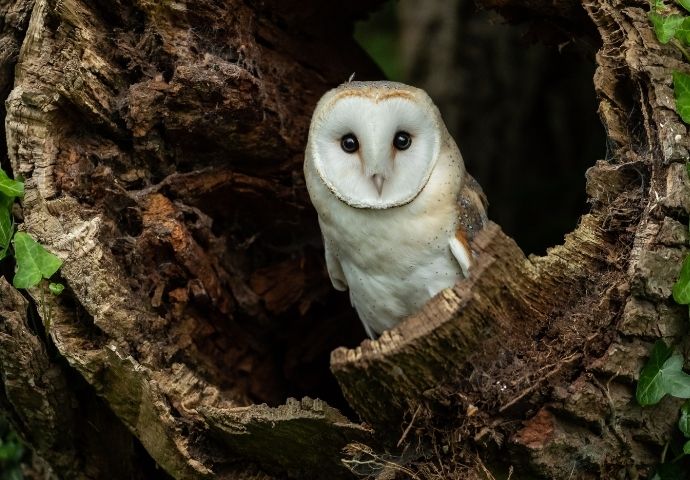
Birds of North Carolina Guide
- American Goldfinch (Spinus tristis)
- Barn Swallow (Hirundo rustica)
- Baltimore Oriole (Icterus galbula)
- Black and White Warbler (Mniotilta varia)
- Carolina Chickadee (Poecile carolinensis)
- Carolina Wren (Thyothorus ludovicianus)
- Eastern Bluebird (Sialia sialis)
- Indigo Bunting (Passerina cyanea)
- Ruby-Throated Hummingbird (Archilochus colubris)
- Scarlet Tanager (Piranga olivacea)
- Tufted Titmouse (Baeolophus bicolor)
- White-Breasted Nuthatch (Sitta carolinensis)
- American Woodcock (Scolopax minor)
- Belted Kingfisher (Megaceryle alcyon)
- Blue Jay (Cyanocitta cristata)
- Northern Cardinal (Cardinalis cardinalis)
- Pileated Woodpecker (Dryocopus pileatus)
- Wild Turkey (Meleagris gallopavo)
- Wood Duck (Aix sponsa)
- Yellow-Billed Cuckoo (Coccyzus americanus)
- Yellow-Bellied Sapsucker (Sphyrapicus varius)
- Bald Eagle (Haliaeetus leucocephalus)
- Barred Owl (Strix varia)
- Great Blue Heron (Ardea herodias)
- Red-Tailed Hawk (Buteo jamaicensis)
READ MORE: The 10 Best Things to Do in Winston Salem NC
Hummingbirds & Other Small Birds of North Carolina
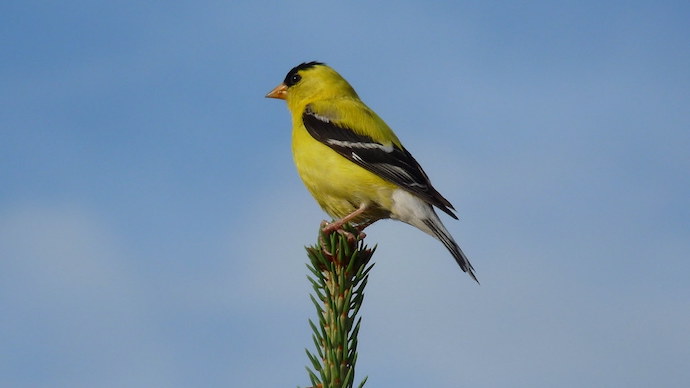
1. American Goldfinch
Spinus tristis
Among the more common backyard birds of North Carolina (and much of the US), American goldfinches deserve recognition for their sweet songs and flashy yellow and black feathers.
These charming birds are found in semi-open areas, such as forest edges, roadsides, and the suburbs, foraging for seeds and small insects.
Seeds from the daisy family are a popular goldfinch favorite. They are also fans of backyard feeders.
Goldfinches are arguably the most common yellow birds in NC, and I frequently spot them at a friend’s bird feeder.
READ MORE: The Best Hiking in Asheville NC Bucket List (Top 25 Hiking Trails)
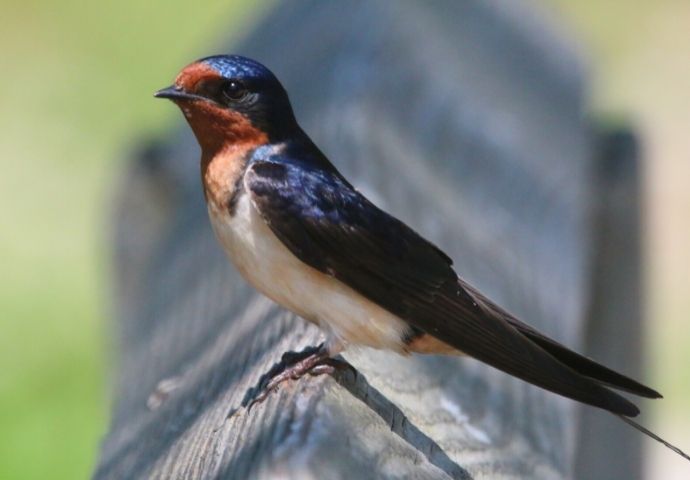
2. Barn Swallow
Hirundo rustica
More likely to be seen in rural areas, barn swallows are birds common to North Carolina (and much of North America).
But they’re so fashionably dressed in vibrant red, white, and blue that they are a pleasure to see.
As their name suggests, these birds frequently nest in barns on NC farms, creating muddy nests that cling to the beams. They also frequently settle under bridges, beneath overpasses, and in garages.
Barn swallows feed on flying insects, which they catch with a barrage of aerial maneuvers and generally eat while on the move.
These birds migrate to the North Carolina mountains in March and depart in October, during which time they breed.
We have had several of them nest right under the roof of our porch.
READ MORE: The 20 Best Blue Ridge Parkway Overlooks in NC & VA
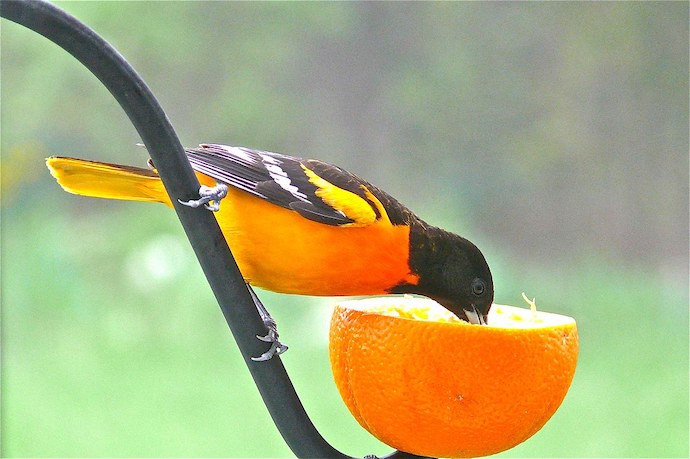
3. Baltimore Oriole
Icterus galbula
With a pretty song and equally attractive plumage, the Baltimore oriole is a familiar bird because of its distinctive coloring and being a classic MLB team mascot.
While North Carolina might not be the first state to come to mind when thinking of Baltimore orioles, Western North Carolina is one of the important regions where they come to breed.
They typically arrive in late spring and stay through the summer.
With brilliant orange chests and bellies and black and white wings, Baltimore orioles stand out in the forest openings and riverside buffers where they like to settle, particularly in elm trees.
This bird snacks on insects, berries, the nectar of North Carolina wildflowers, and even sugar water left out for hummingbirds!
READ MORE: The 15 Best Boone NC Hiking Trails to Explore

4. Black and White Warbler
Mniotilta varia
There are dozens of warblers in the list of frequently seen North Carolina backyard birds.
Narrowing it down to one type to give other species some attention just seems fair, and the black and white warbler is as attractive as any other variety.
Though black birds aren’t normally what most people think of as beautiful, the black and white warbler has a stunning pattern of stripes and shapes that make it stand out.
These birds live in mature and/or second-growth forests, which is what much of the NC wildlands have.
Black and white warblers breed in the forests of Western North Carolina, where the Pisgah National Forest, Nantahala National Forest, and Great Smoky Mountains National Park provide ample nesting grounds.
Unique among warblers, they climb around on tree trunks and limbs looking for insects between pieces of bark. They also eat from low parts of the tree and like to nest on the ground.
READ MORE: The 20 Best Pisgah National Forest Hiking Trails in North Carolina

5. Carolina Chickadee
Poecile carolinensis
Named by John James Audubon, the Carolina Chickadee was named in South Carolina but inhabits states as far north as Pennsylvania.
It has a black cap and a black bib with gray wings and a white underside. In fact, it looks so much like the black-capped chickadee that the two often (successfully) mate.
These birds mate as couples for several years, and they live in small flocks of up to eight birds. The flocks defend their territory against other flocks.
Carolina chickadees like to nest in boxes and/or tubes filled with sawdust or wood shavings. Naturally, they like forested areas, but they are at home in urban and suburban parks.
They like to eat typical bird-feeder fodder like sunflower seeds and peanuts, as well as suet.
READ MORE: 25 Beautiful Birds of Georgia
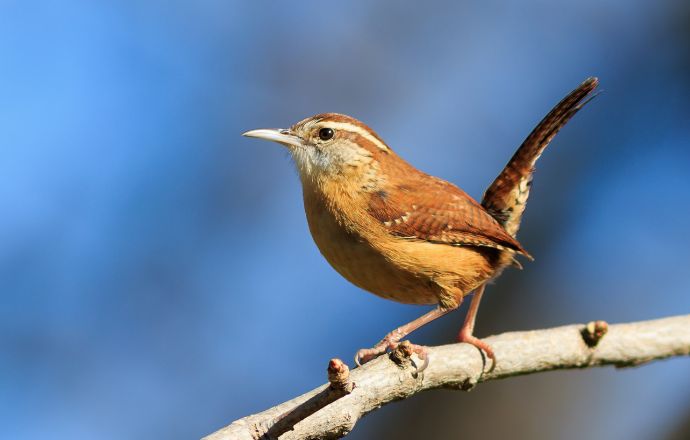
6. Carolina Wren
Thyothorus ludovicianus
We, as do many NC residents in our area, have a special relationship with the Carolina wren. For years now, a couple has nested at our house, and we’ve gotten to see the babies. Carolina wrens mate for life and remain in their territory.
Amazingly, the first time we discovered the nest, a friend told us to look out for eggs. And, once there was an egg, a new one would follow each day until there were five. It happened exactly that way!
Carolina wrens are happy, plump little birds with cinnamon-colored feathers and an upturned tail. The males sing a lot, something that apparently sounds like “teakettle-teakettle”.
They are supposed to be shy, but our birds are constantly hanging out on the back porch and woodshed, hopping around in search of insects.
Despite the name, Carolina wrens aren’t just residents of the Carolinas. They are found throughout the entire Southeast region, pushing west and north into bordering states.
READ MORE: 20 Beautiful Birds of Virginia
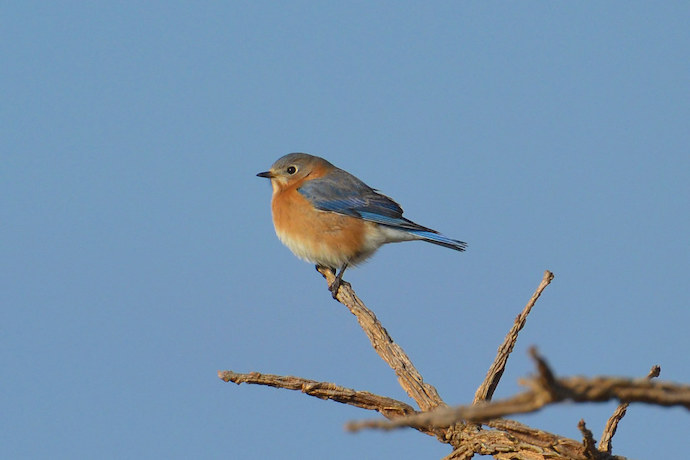
7. Eastern Bluebird
Sialia sialis
A year-round resident of the state, Eastern bluebirds in North Carolina are amongst the cutest backyard birds a person can spot.
They have bright blue backs, rusty red breasts, and white accents to set it all off.
They feed on insects and berries, and are prone to flittering back and forth to catch dinner (with grasshoppers and beetles being their favorite dish). They’re also known to eat earthworms, snails, and even lizards on occasion.
The bluebirds of NC are commonly spotted roaming around the countryside in little flocks, and they love to nest in specially built birdhouses.
We see Eastern bluebirds in our permaculture garden all the time, and they’re always a fetching beauty to behold.
READ MORE: The 30 Best Things to Do in Asheville NC
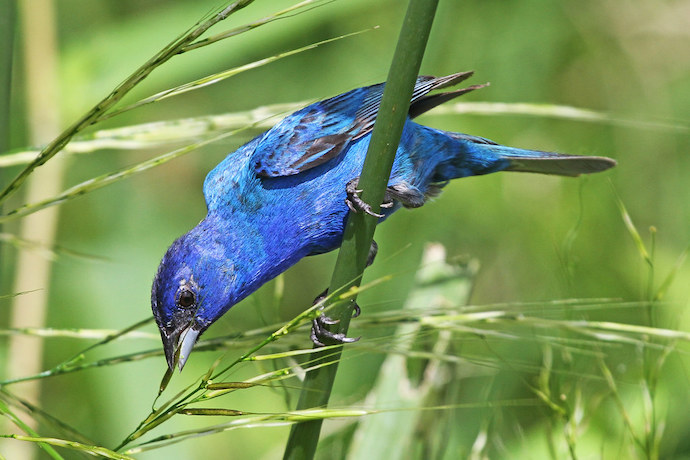
8. Indigo Bunting
Passerina cyanea
Even more ridiculously blue than actual bluebirds, indigo buntings are a breeding bird in North Carolina. They’re typically present in the summer, hanging out in spaces up to 4500 feet in elevation.
Indigo buntings are easy to spot and gorgeous to see, and they love to whistle a lively tune.
They’re common to North Carolina from east to west and top to bottom.
These vibrant birds feed on insects, seeds, and berries, typically foraging alone during the season and with the female (who’s usually in charge of feeding the young) after mating.
Famed for their singing, indigo buntings are a common sight along roadsides, and they like to nest in brushy thickets where it’s easy to hide from predators.
READ MORE: The 25 Best Blue Ridge Parkway Hikes for NC Day Trips

9. Ruby-Throated Hummingbird
Archilochus colubris
The most common of the 9 species of hummingbirds in North Carolina, the ruby-throated hummingbird is a regular sight during the summertime.
It’s usually buzzing from flower to flower, with tiny wings flapping 50 times a minute.
Ruby-throated hummingbirds are regular visitors that nest along the East Coast, from Canada to Florida, every year.
While not full-time NC residents, they are a seasonal species, and some have been recorded as staying all year.
Like other high-energy hummingbirds, the ruby-throated loves flowers, particularly red flowers, and they are seemingly always hopped up on sugary nectar.
We have one ruby-throated hummingbird that hangs out in our garden every year. It even meets us there for breakfast most mornings once the weather turns warm.
READ MORE: The Top 10 Treehouse Rentals near Asheville, NC
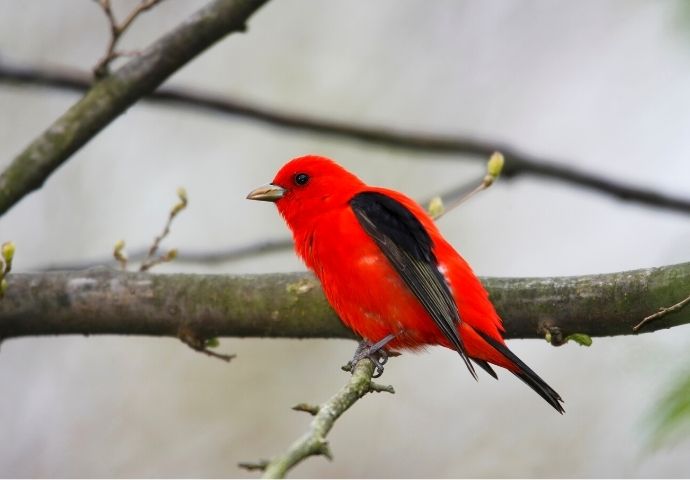
10. Scarlet Tanager
Piranga olivacea
The male specimens of the scarlet tanager are so ridiculously bright red (and starkly black) that they don’t seem to belong in nature. The females look completely different, with yellow bodies and gray wings.
These brilliant birds are summertime residents of the pine-oak forests of Western North Carolina.
They like to hang out near the tops of trees, looking for insects amongst the leaves or picking at little berries. They nest far up in the trees, about 20 to 30 feet from the ground.
Despite being the brightest red bird in North Carolina, the scarlet tanager can be rather tough to spot due to their preference for staying high in the forest canopy.
But they can sometimes be seen in lower shrubs when the temperature drops a bit.
READ MORE: The Best Things to Do in DuPont State Forest, NC
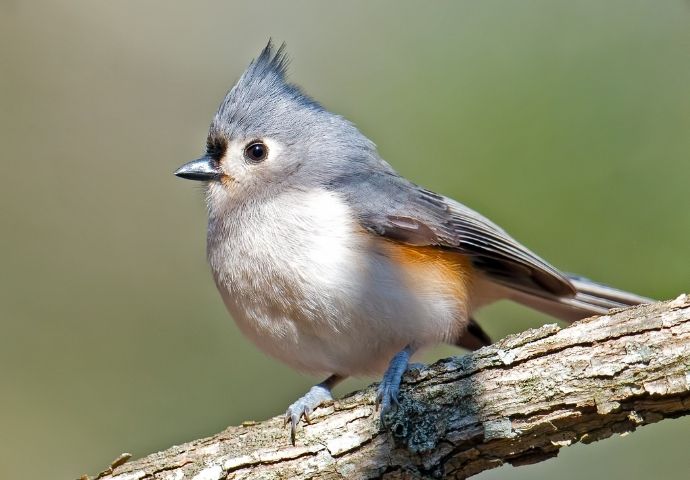
11. Tufted Titmouse
Baeolophus bicolor
The ubiquitous tufted titmouse is a mainstay among the small birds in North Carolina, and can be spotted here all year round.
It likes deciduous forests all along the East Coast, and it frequents bird feeders.
These beautiful birds have gray-blue wings and crown, a white belly, and accents of black and potentially red.
The tufted titmouse likes to dance about on tree branches and twigs, and they are known to hang upside down from them as well.
They often like to sing while doing it, particularly during Winter thaws.
READ MORE: The 25 Best Western NC Small Towns To Visit (and Live In!)
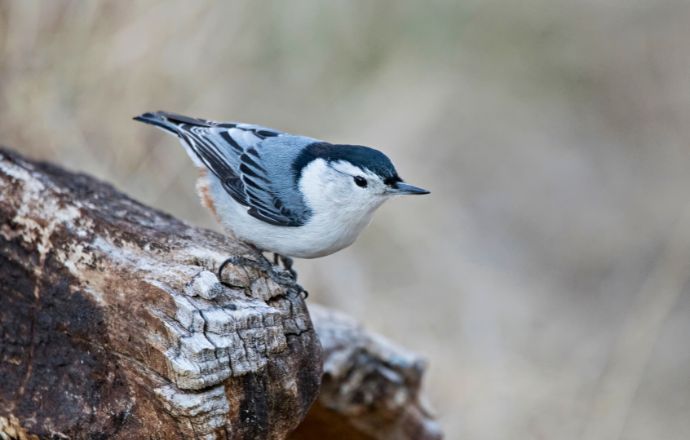
12. White-Breasted Nuthatch
Sitta carolinensis
The white-breasted nuthatch hangs its feather hat in North Carolina all year, and it is an easy bird to spot around feeders. One of our dear friends has a feeder on her balcony that these birds love.
Obviously, the white-breasted nuthatch has a white chest. It has gray and black feathers on its head and back, and there is some ruddy fluff under the tail feathers.
In addition to eating insects, these little birds love plump seeds like sunflowers and nuts. They have the habit of wedging nuts into the bark of trees and pecking the shells until they open or “hatch”.
Nuthatches are small birds, but they are very vocal. They love to turn sideways or upside down when foraging on tree trunks.
White-breasted nuthatches are likely to be found in mature forests and forest edges, typically in deciduous forests with maples, oaks, and hickories.
READ MORE: 7 Covered Bridges in North Carolina You Can Visit in 1 Day
Woodpeckers & Other Special Birds of North Carolina

13. American Woodcock
Scolopax minor
Emma and I spotted our first woodcock sauntering along a gravel road in the NC Piedmont. It was a strange, chubby little thing with a huge beak and funny gait. It disappeared into a thicket of brush growing beside a creek branch.
For those lucky enough to see one, the American woodcock is a rather humorous bird to watch as waddles along the forest floor in search of worms. It’s a relative of coastal birds but prefers to stay in the forests and fields of eastern North America.
American woodcocks are mottled brown, blending in with the leaf litter, and they have large eyes. The best time to look for them is at dusk or dawn in the spring because males call for females and put on aerial displays to win them over.
Woodcocks, also known as timberdoodles, bog suckers, and Labrador twisters, are year-round birds in North Carolina.
READ MORE: The 13 Best Blue Ridge Parkway Campgrounds to Visit
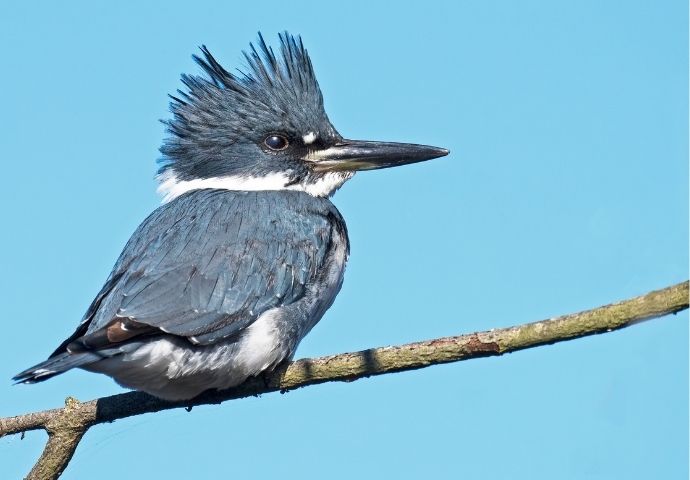
14. Belted Kingfisher
Megaceryle alcyon
Belted kingfishers are most often heard before they’re seen.
They dash and dart from tree to tree as they fly over rivers, streams, and lakes. All the while, they tend to let forth a cacophonous call that warns any competitors.
The belted kingfisher is an all-season bird in North Carolina, and they’re an exciting sight when visiting our local waterways. They’re blue and white with touches of red, and regal tufts of feathers atop their heads.
They like to perch on branches and dive straight down, plunging into the water to catch small fish and occasionally frogs, tadpoles, and crawfish.
We will frequently sit and watch a talkative kingfisher hunting over our pond.
READ MORE: The 10 Best Lakes in the North Carolina Mountains to Visit

15. Blue Jay
Cyanocitta cristata
Blue jays are permanent residents of Western North Carolina, and they may just be the prettiest of the blue birds of NC.
They have stunning blue wings and tail feathers, white bellies, and lots of black markings.
Aside from being beautiful birds, blue jays are very clever (a close relative of crows and ravens). They sing a wide variety of songs, including a strangely great imitation of red-shouldered hawks.
They like to hang out in trees and eat an omnivorous diet of hard nuts, seeds, grains, berries, small fruits, and plenty of insects. Blue jays are even known to eat small animals like frogs, rodents, and other birds.
We often see them in the alder trees at the edge of our forest.
READ MORE: The Top 25 Blue Ridge Mountain Towns in GA & NC

16. Northern Cardinal
Cardinalis cardinalis
The northern cardinal is not only the North Carolina state bird, but also the state bird of Indiana, Illinois, Kentucky, Ohio, West Virginia, and Virginia. They’re all-season inhabitants of all states east of the Rockies.
Cardinals have a varied diet that includes seeds and berries, as well as lots of insects, spiders, and even snails.
They love visiting bird feeders, with a special penchant for sunflower seeds. They also like to hop around on the ground or in low bushes in search of dinner.
Male cardinals are the signature image, with vibrant red bodies and black markings around the eyes and wings.
Female cardinals tend to be a bit more drab in coloring, with more earthy tones and little flashes of red.
READ MORE: The 15 Best Things to Do in Banner Elk NC
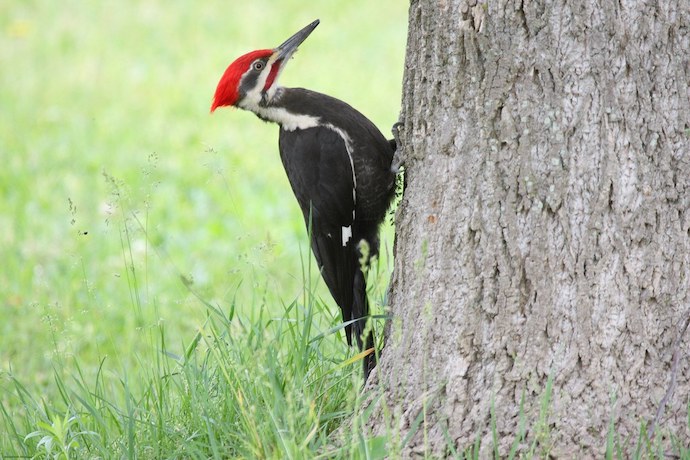
17. Pileated Woodpeckers
Dryocopus pileatus
Aside from the likely extinct ivory-bill woodpecker, pileated woodpeckers are the largest woodpeckers in North America.
Roughly the size of a crow, they can grow up to 19 inches tall. Their bodies are black with white underwing patches.
The head has white and red markings, including a red crest that stretches from the beak to the back of the head.
They’re full-time residents in the coastal Southeast, with less frequency as things move further inland and north.
We often saw a family of pileated woodpeckers in the woods around the cabin rental we lived in while building our homestead. They were great fun to watch, but quite loud echoing through the forest!
READ MORE: The 52 Best Hikes in North Carolina for the 52 Hikes Challenge

18. Wild Turkeys
Meleagris gallopavo
Somewhere between beautiful and horrifying (see: wattles), wild turkeys are exciting to see, and they’re often heard long before they’re spotted.
Turkeys usually roam around in flocks. They can fly in a pinch (which is quite a sight), but it’s really a rarity.
They scratch up leaf litter in search of insects and small animals, as well as seeds, grains, berries, bulbs, and more.
We see turkeys at the edges of forests often, both around our house and in nearby Stone Mountain State Park. They also like to congregate in empty corn fields.
Turkeys mate in spring, and this is a great time to spot them. That’s when the males are likely to be putting on those elaborate feather displays, much like the peacock.
READ MORE: The 20 Best Pumpkin Patches in the NC Mountains

19. Wood Ducks
Aix sponsa
Wood ducks live in North Carolina year-round, but they can be quite elusive.
They’re very shy, and tend to dash away quickly when people are around.
The male wood duck has really shocking coloring on its head. It has an elaborate geometric design of black, white, red, and green, capped off with a little feathery flap at the back of its head.
These ducks are woodland creatures, looking for shallow lakes, swamps, and slow-moving streams that are bordered by forests.
We have a mating pair of wood ducks that visits us every spring during their nesting season.
READ MORE: The 15 Best Pisgah National Forest Waterfalls to Explore
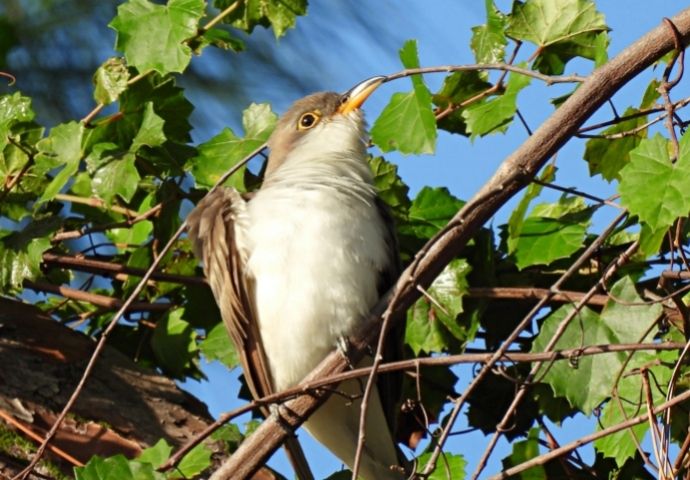
20. Yellow-Billed Cuckoo
Coccyzus americanus
North Carolina is a breeding ground for the yellow-billed cuckoo (and the black-billed cuckoo), which comes in the spring and departs when fall colors arrive in Western NC.
Yellow-billed cuckoos are sometimes referred to as “rain crows,” because they tend to let out their distinctive calls as storms approach. They often call out in response to loud noises, such as thunder.
Yellow-billed cuckoos are brown (back) and white (belly) birds that make this list because of the cool patterns on their long tail feathers. Black-billed cuckoos have similar coloring, with different tail patterns.
These NC birds can be somewhat difficult to spot, but much easier to hear. Keeping an eye out for trees with tent caterpillars is a good place to start.
READ MORE: 3 Great Places for Ziplining in Boone NC (and Other Aerial Adventures)
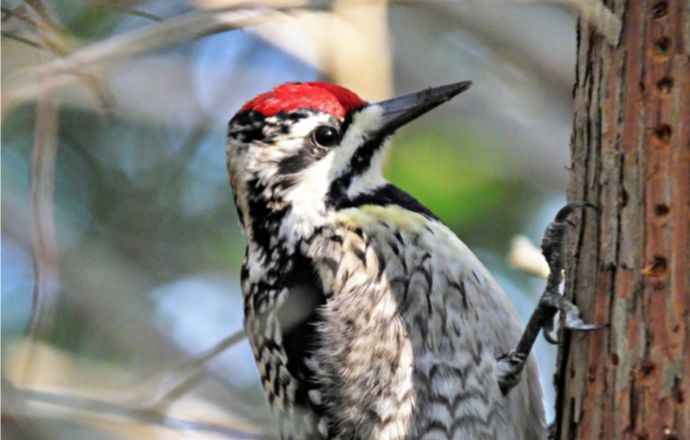
21. Yellow-Bellied Sapsucker
Sphyrapicus varius
We discovered the yellow-bellied sapsucker when we noticed its signature marks on a kousa dogwood tree we were pruning. The geometric pattern of removed bark was remarkable, and we began our Sherlock Holmes mission to figure out what made them.
Yellow-bellied sapsuckers peck small holes, called sap wells, in the tree bark so that they can lick up sap with their brush-like tongues. They also pick up any insects unlucky to be around. They sit at these spots for a long time feeding.
This bird is actually a type of woodpecker, with coloring much like the much larger pileated woodpecker. They have red caps, red chins, mottled white bellies with black features, and mottled black backs with white features.
They are migratory, visiting North Carolina in the wintertime, and they are most likely found in young deciduous forests. Yellow-bellied woodpecker sap wells have been found on over 1000 species of trees.
Look for them in backyards with young birch and maple trees. They know where the good sap is!
READ MORE: The 20 Best Places to Visit in North Carolina
Owls & Other North Carolina Birds of Prey
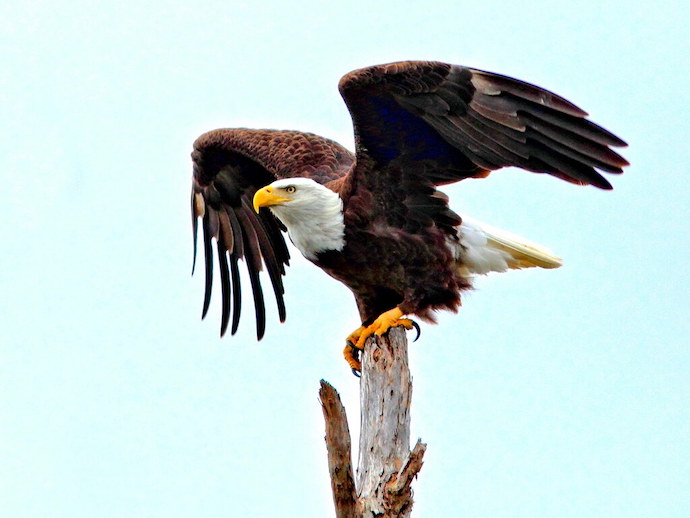
22. Bald Eagle
Haliaeetus leucocephalus
Bald eagles are always a grand sighting– huge and very distinctive– not to mention one of North Carolina’s fiercest native birds.
Bald eagle populations declined severely during the early and mid-1900s, when they were regularly shot and subjected to DDT and other pesticides. But they’ve been making a valiant comeback since the 1970s.
It’s best to look for bald eagles around bodies of water, such as large lakes, sprawling swamps, and wide rivers.
They are notoriously opportunistic eaters, willing to hunt (preferring fish), steal, or scavenge their meal.
We’ve spotted a couple of bald eagles near the rivers in the Yadkin Valley, just east of Boone NC and the Blue Ridge Parkway.
READ MORE: 20 Best Things to Do in Boone NC (Blue Ridge Parkway MM 291.8)

23. Barred Owl
Strix varia
One of the great birds of prey in NC, barred owls are common, year-round residents in the state (and much of the eastern U.S.).
They have brown and white feathers, with a very traditionally owlish face.
They’re awesome hunters, usually in pursuit of small rodents. They like to eat mice, squirrels, rabbits, shrews, and more. In a pinch, they’ll even go after amphibians, reptiles, and fish as well.
Though we think of owls as nighttime creatures, barred owls will hunt during both day and night. In fact, they are best spotted as dawn and dusk, typically in pursuit of something.
We had a fleeting encounter with a barred owl on the way to work one morning, as it swooshed in front of the car.
READ MORE: The 15 Best Things to Do in Blowing Rock NC

24. Great Blue Heron
Ardea herodias
Great blue herons are mesmerizing to watch as they stalk around in the shallows. They are at once serene and also seriously intense.
They’re always on the hunt for fish, as well as frogs, turtles, salamanders, snakes, and other water-loving creatures.
One of the largest birds native to North Carolina, the great blue heron can stand over four feet tall and have a wingspan exceeding six feet.
They glide with ease and can walk around comfortably in a couple of feet of water.
We have a lovely heron that visits our pond, which is filled with frogs, salamanders, and fish, several times a week.
READ MORE: Non-Venomous vs Venomous Snakes in North Carolina (ID Guide)
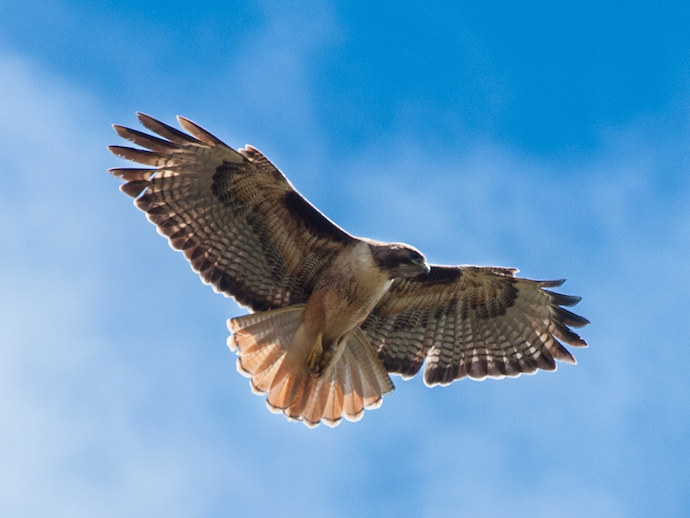
25. Red-Tailed Hawk
Buteo jamaicensis
There are numerous types of hawks in NC, but the red-tailed hawk is the most often seen of the larger natives. It can stand two feet tall, and has a wingspan of around four feet.
Adult red-tailed hawks have mottled brown feathers on their backs and white undersides with a brown band across it. As the name implies, their tales are a rusty red.
They like to live in the forest, particularly with open country nearby, though they will tolerate some urbanity. They often perch high in trees to look for small rodents to eat.
Red-tailed hawks are very common, found in all 100 counties in North Carolina.
We see them much more than any other hawk species, though we do see a red-shouldered hawk at our homestead from time to time. –by Jonathon Engels, featured photo of a Pileated Woodpecker in NC via Canva

